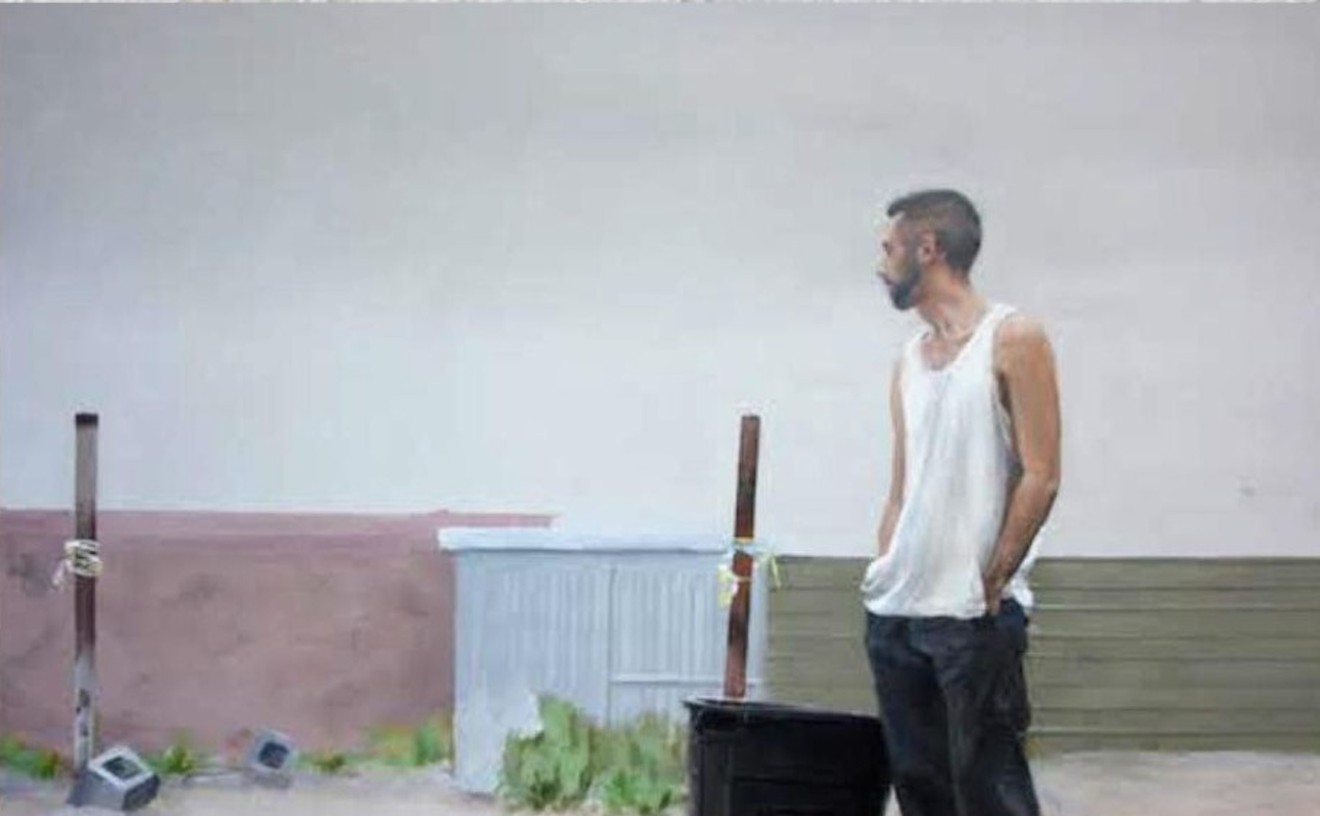At first, I was disappointed with the show. I naively thought the collection would make me cackle. But this exhibition is seriously funny — not just funny. And once I gave that concept more thought, a new appreciation for SMoCA's 10th anniversary exhibition emerged.
Comedy is subjective. It takes a magical alignment of a million elements, catered to one individual's unique referential mind, to pop together just right to produce a smirk, snort, chuckle, or roar. We all take turns either getting the joke or missing the punch line. So curators Claire Schneider and Cassandra Coblentz took a different approach.
"It's not really about being funny," Coblentz says. "It's more about how funny works."
Schneider and Coblentz present a collection by 10 artists — including the international famous as well as local talent (to represent the diversity of artists SMoCA's shown over the decade) — who deal with less-than-funny topics. Some pieces worked for me, and some didn't. But I had to think long and hard as to why or why not. Which is exactly what the curators want.
While I didn't wet myself laughing, I found a few works funny. Kjellgren Alkire is the only local artist featured, but I thought he was one of the best in the show. He definitely made me smirk with Cowboy Confessional. This structure towers over an entire gallery filled with a makeshift congregation of tree stumps, a shed-like pulpit, and outdoor camping scenes painted on the walls. Two elongated outhouses are perched on an open-air flatbed single-axle trailer. Viewers are invited to enter the confessional and sit over the toilet holes. I encourage this activity because without the exploration, you'd miss the cathedral-like feel when you look up the towering walls and see a soft glow. Then, glancing to the side, you can see your neighbor through a window — just like a confessional. Poo-poo humor may not be the most mature way to make someone laugh, but Alkire puts his viewers in a position to essentially take a dump on one of the sacraments. Maybe I'm a child because I think that's pretty dang funny.
Alejandro Diaz's Make Your Own Damn Tortillas was the other hit for me. The installation sits on a series of platforms and is a beautiful setup of tortilla-making items. It's a stunning arrangement of chili peppers, stone mashers, woven mats, gourds, pots and huge wicker baskets holding dried stalks of burgundy, navy and sunshine yellow corn. To the left of the setup is a dusty wood chair with a cardboard sign that reads, "Make your own damn tortillas — I'm outta here — Lupe." This work is absolutely charming. Not to mention, it's a fantastic way to create a portrait of a modern, assimilated Mexican woman.
Dan Perjovschi was the first artist to strike me as way more serious than funny. But that's not to say he wouldn't be someone else's favorite jester. With a show like this, all I can do is explain why he didn't tickle my funny bone. And my reasons don't come without a lot of thought. Again, it's this kind of investigation that Schneider and Coblentz aim to inspire.
Perjovschi, a Romanian artist, has his run with the entire back west wall of the galleries. He covers the white surface with his signature black scribbles of sketchbook-style stick figures and cartoons. Each vignette in this visual stream of consciousness makes social or political commentary.
The sketch I related to most is a stick figure wearing a Barack Obama T-shirt inscribed with "HOPE." The stick figure's head is bent over, looking down at his own front as he yells, "YOU HAVE TO DELIVER." Perjovschi drew the sketch around last year's presidential election and I share his anticipation of an inevitable Obama backlash. Having so much hope in one man is dangerous. Another sketch that hit close to home was a crowd of round-bellied figures gathering around a SALE window filled with thinner stick figures. The words "PERFECT PEOPLE" are written above the image with an arrow pointing into the window. Yep, that's a social pressure I know very well.
Perjovschi uses stick figures to cushion these issues, but, though charming, the figures just weren't enough of a buffer to keep the subject matter light for me — not enough distance. Then again, I'm used to The Daily Show, SNL, or The Onion to keep this kind of stuff funny. Nonetheless, it turned out to be the most thought-provoking work, purely because I didn't find it funny. I now see that I need a lot of bells and whistles, via TV or Internet, to make me laugh at social/political satire.
And then there were the sculptures by Maurizio Cattelan. This is where the heaviness outweighed the humor. Frank and Jamie, 2001 consists of two wax figures — uniformed NYPD officers — leaning against the wall. But they're upside down: heads on the floor, toes to the ceiling. One is a lovable buffoon. He's portly with a goofy grin. The other is slim and carries a stern face. This is Cattelan's commemoration of September 11. It symbolizes the total upsetting of control, safety, and authority caused by the tragedy. The officers, aside from standing on their heads, are extremely lifelike. And, in my imagination, they come alive — but only for a moment. I see them screaming as they are burnt alive or crushed to death by falling debris. Again, it doesn't offer enough distance from the heavy subject matter to be funny.
Obviously, the curators found an element of humor in all the pieces. It's up to the audience to agree or disagree. All SMoCA is asking here is to think about why. They certainly did that. And you just read about a thousand words of proof.










